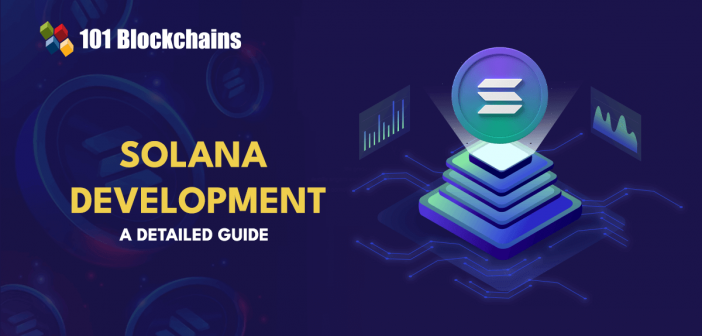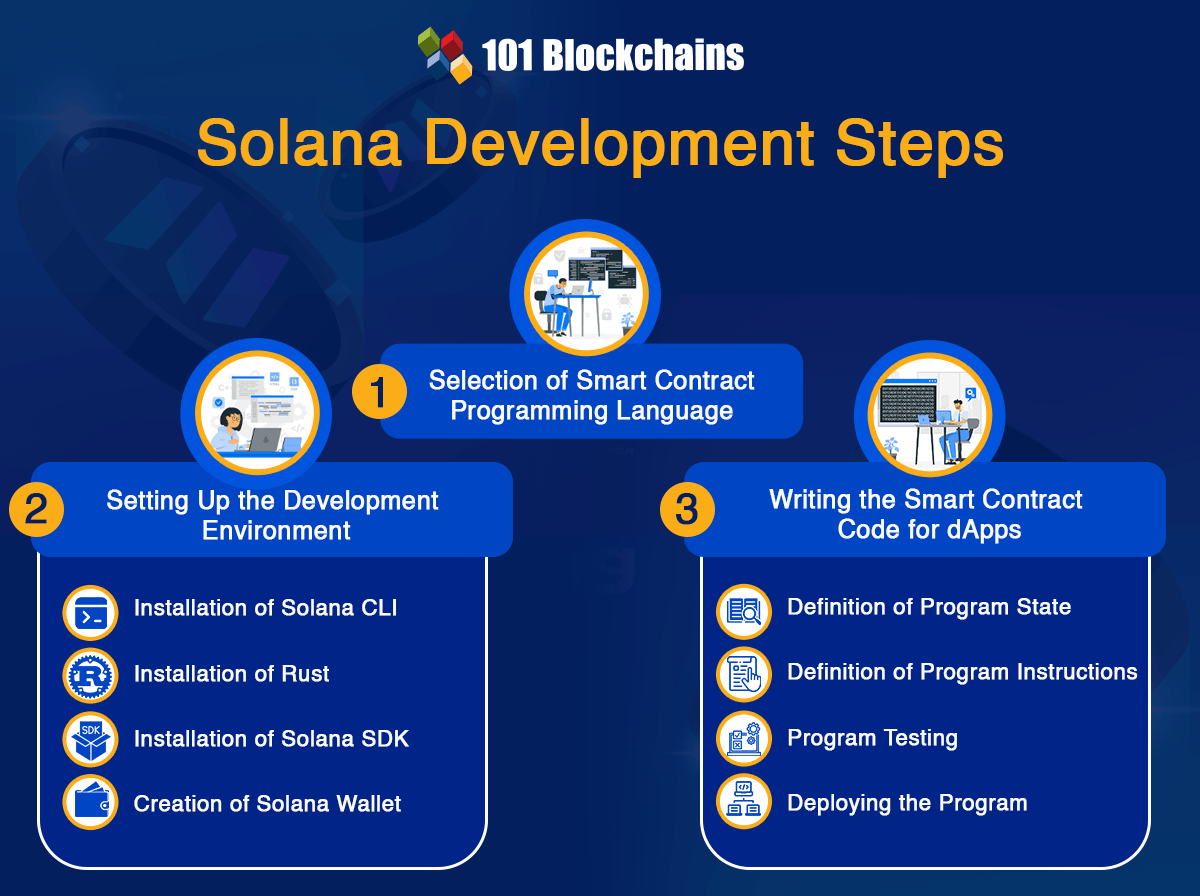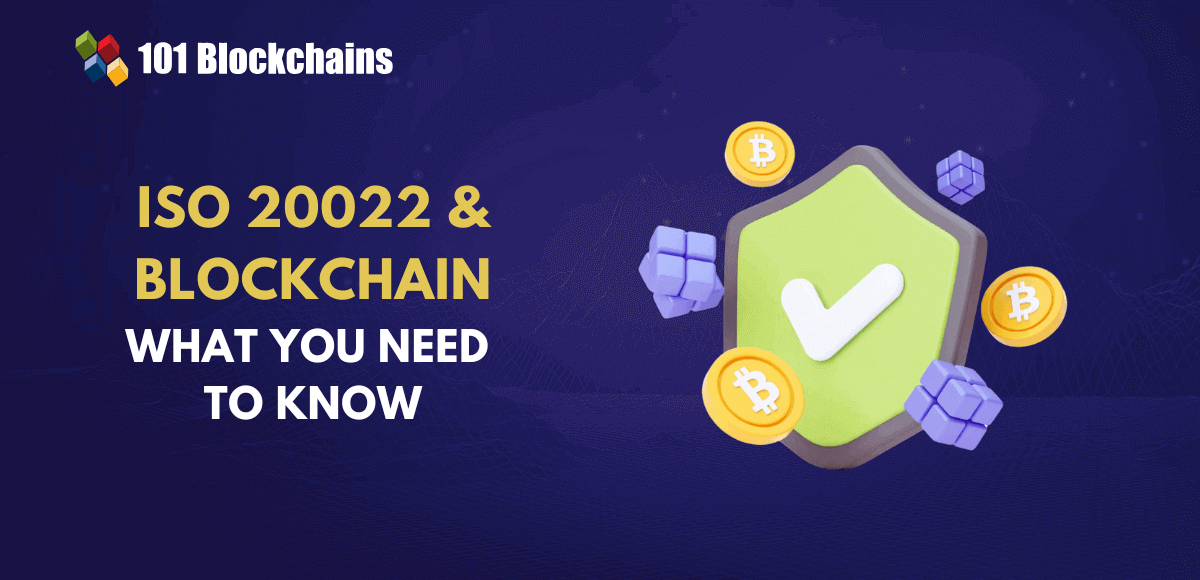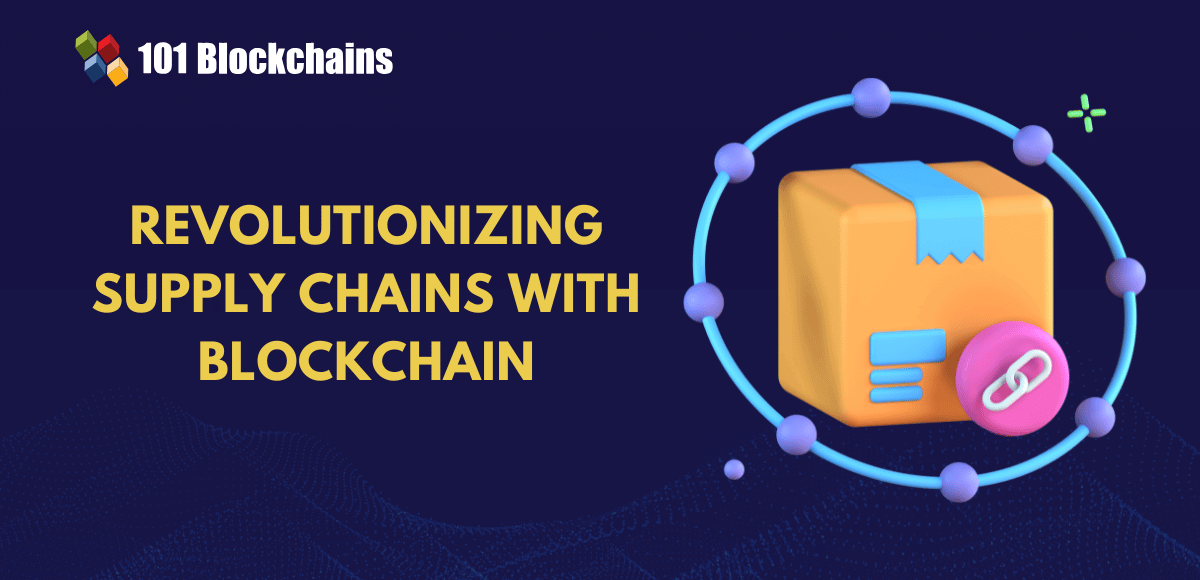Learn how blockchain truly works, master key definitions, and uncover what makes smart contracts so "smart." Dive into the fundamentals, gain valuable insights, and start your blockchain journey today!

- Blockchain
Georgia Weston
- on December 27, 2023
Getting Started with Solana Development
Solana has emerged as one of the prominent solutions similar to the ‘world computer’ visualized in the early era of cryptocurrencies. It is one of the most compelling layers 1 blockchain with multiple improvements over existing blockchain networks. The value, benefits, and popularity of Solana must have brought you here in search of a Solana development guide for learning about the best practices for building decentralized solutions on Solana.
Some of the notable features of Solana blockchain include low latency, asynchronous BFT consensus, high throughput, and inexpensive transaction fees. In addition, it also utilizes Rust as the flagship programming language and a single global state that supports composable smart contracts.
Developers working on smart contracts have some apprehensions in dealing with layer 2 solutions and sharding. The scaling solutions lead to complexities for application developers, such as creating ecosystem baggage. On the other hand, Solana development tools could help you avoid the need for scaling solutions. Therefore, the interest in learning about Solana’s development has been gaining momentum. Let us learn more about how you can start working on Solana development projects.
What is Solana?
The first thing you need to learn before specializing in Solana development is a description of unique traits of Solana. Solana is a blockchain platform tailored to offer a highly scalable and efficient solution for developing decentralized applications. The answers to “What is Solana development?” also focus on optimizing the architecture of Solana blockchain for achieving lower latency and higher throughput.
As a result, it could support more transactions per transaction without any delays. The unique highlight of Solana architecture is the Proof of History consensus mechanism. The consensus mechanism offers an immutable and verifiable arrangement of events in a sequence to help validators reach a consensus on the network state without involving resource-intensive and time-consuming processes such as mining.
Proof of History is an interesting element for anyone who wants to learn Solana development fundamentals. The consensus mechanism involves generating a sequential and continuous record of all events on Solana blockchain network. Subsequently, the record of events could help in ordering and validating transactions. Furthermore, Proof of History consensus also offers proof of the time at which a certain event occurs. As a result, validators could easily achieve consensus regarding order of events within the network.
Excited to learn about the fundamentals of Solana and Solana smart contracts development, Enroll now in the Solana Development Course.
What are the Other Features of Solana Blockchain?
Apart from Proof of History consensus, Solana blockchain also utilizes other technologies for optimization of network performance. You can develop Solana app by leveraging the benefits of important components, such as Tower BFT, Sealevel, Gulf Stream, and Turbine. Tower BFT is a variant of the Practical Byzantine Fault Tolerance or PBFT consensus algorithm.
Gulf Stream is a unique block propagation tool for faster and more efficient propagation of blocks across the network. Sealevel is the parallel processing architecture that helps Solana scale horizontally across different nodes in the network. Turbine is the transaction processing engine that enables faster and more efficient processing of transactions.
The architecture of Solana has been tailored to ensure low latency and higher throughput. In addition, the other technologies used in Solana blockchain also ensure higher scalability and performance for developing decentralized applications.
Create new, high-level, innovative blockchain solutions for different industries as a highly-skilled blockchain developer with Blockchain Developer Career Path
Why Should You Learn about Solana Development?
The next thing on your mind while reading this Solana development guide would be the outline of reasons for learning Solana development. Solana is an ideal choice for developing decentralized applications with the assurance of better speed and scalability. Here are some of the notable reasons for which you should invest time in learning the best practices for Solana development.
-
Improved Scalability
Solana can serve as a promising alternative to layer 2 scaling solutions for its optimized architecture to ensure scalability. It can help in designing decentralized apps that could manage a higher volume of transactions, such as for decentralized exchanges and web3 games.
-
Collection of Advanced Features
The collection of Solana development tools serves unique functionalities that improve the dApp development lifecycle with unique benefits. It offers multiple advanced features that can help you create innovative dApps. In addition, it also supports layer 2 scalability solutions such as optimistic rollups.
-
Expanding Ecosystem
The continuously growing ecosystem of investors, entrepreneurs, and developers using Solana blockchain has been driving its popularity. You can learn Solana development and become an invaluable part of the community by contributing to the growth of Solana blockchain.
Most important of all, the growing popularity of Solana also invites more demand for developers with specialization in Solana development. With the right skills for Solana development, you can become a valuable asset for companies that want to develop dApps on Solana.
Are you aspiring to learn the fundamentals of the Ethereum Virtual Machine and smart contracts’ upgradability? Enroll now in the Advanced Solidity Development Course.
Step-by-Step Process for Solana Development
The features of Solana blockchain prove why it has become one of the popular tools for developing decentralized apps. You can find responses to “What is Solana development?” by considering the examples of Solana development projects. Let us take the example of a project for developing smart contracts on Solana blockchain. Here is an outline of the mandatory steps involved in the process of developing smart contracts on Solana.

1. Selection of Smart Contract Programming Language
You might be quick to assume that Solidity is the only trusted programming language for creating smart contract code. However, you have to take a detour from the conventional route for developing smart contracts on the Solana blockchain. Solana offers support for different programming languages, albeit with priority for Rust. It is the popular language for creating smart contract code on Solana blockchain.
What are the main reasons to develop Solana app with Rust? Rust offers multiple advantages, including memory safety, speed, and extensive community support. As a statically typed language, every variable type in Rust is visible only at compile time, thereby preventing multiple memory-related errors, such as null pointer dereferences and buffer overflows. The assurance of memory safety with Rust can ensure improved security and resilience of smart contracts against prominent vulnerabilities.
Rust also offers the advantage of speed as a compiled language by ensuring optimization at compile time for better performance. As a result, it could ensure faster execution time while limiting resource usage. Therefore, Solana development tools can help in developing applications that need higher scalability and performance.
On top of it, Rust also delivers better tooling and extensive community support for developing solutions on Solana blockchain. It features multiple libraries and frameworks for interacting with the Solana software development kit or SDK. Developers could also leverage Anchor, a Rust-based development framework, to access different tools and abstractions to create Solana smart contracts.
Curious to understand the complete smart contract development lifecycle? Enroll now in the Smart Contracts Development Course
2. Setting Up the Development Environment
The next step of building and deploying smart contracts on Solana involves setting up the development environment. Here are the different steps involved in setting up the development environment on Solana.
-
Installation of Solana CLI
Solana command-line interface or CLI is the crucial tool for interactions with Solana network. Any Solana development guide must focus on installation of the Solana CLI by following important instructions on the official website of Solana. The instructions for installing Solana CLI could vary according to the operating system. The Solana CLI serves as a crucial tool for deployment, management, and interactions with smart contracts on Solana network.
-
Installation of Rust
Rust is the most popular programming language for developing dApps and smart contracts on Solana. You can download Rust from their official website and follow the relevant instructions for your concerned operating system. One of the important aspects in answers to “What is Solana development?” points at Rustup. It is a popular tool for installation and management of Rust and can also help in installing the Rust package manager, Cargo, alongside other dependencies needed for Solana development.
-
Installation of Solana SDK
The Solana SDK is another important resource required for developing on Solana blockchain. It offers a collection of Solana development tools, templates, and libraries for development of Solana smart contracts. You can use the simple command “Cargo install Solana-SDK” in the terminal to install the Solana SDK. The command can help in downloading and installing Solana SDK alongside other dependencies.
-
Creation of Solana Wallet
Another important component required for Solana development is the Solana wallet. It can facilitate interaction with the Solana network, signing transactions, and deploying smart contracts. Solana developers can leverage the Solana CLI to create a Solana wallet or use a web-based wallet. After creating the wallet, you should save the recovery phrase in a safe location.
-
Configuration of Development Environment
Once you have installed the essential tools required to develop Solana app and create the wallet, you have to configure the development environment for using the Solana network. The configuration process focuses on setting up the Solana CLI for connecting to the required Solana cluster and providing the address of the new Solana wallet. Interestingly, the Solana documentation could help you access the important instructions for configuring the development environment.
Upon completing all these steps, you can have a completely functional development environment to create and deploy smart contracts on Solana blockchain. Now, you can use the SDK and experiment with different use cases of smart contract development to create dApps on Solana network.
Master the concepts of Solana security and the best practices for creating NFTs on Solana with Solana development course, Read more about Newly launched Solana Development Course.
3. Writing the Smart Contract Code for dApps
With a completely configured development environment, you should focus on writing the smart contract code in the next step. The unique highlight of a Solana development guide is the use of Rust-based programming tool, Anchor. It has been tailored for developing Solana smart contracts with tools for program testing, data serialization, and state management. Here are the recommended steps you should follow in the smart contract coding process for Solana development.
-
Definition of Program State
The state of a smart contract on Solana serves as a representation of persistent data related to the contract. Developers can leverage the data models of Anchor to define the state of the smart contract. The data models of Anchor are Rust structs, which serve as representations of the data fields in the contract. Anchor has the capability for automatically generating the code required for serialization and deserialization of data models to on-chain state accounts.
-
Definition of Program Instructions
The smart contract program instructions provide a definition for the business logic of the contract. Developers could use Solana development tools like the procedural macro framework of Anchor for defining program instructions. The procedural macro framework helps in attaching instructions to Rust functions, which a client could invoke. In addition, you should also define the custom errors alongside event structures that allow users to offer meaningful feedback to clients.
-
Program Testing
The most important aspect for anyone who wants to learn Solana development is the ideal approach for testing your smart contract programs. Interestingly, Anchor offers a framework for local testing of your smart contract code outside the Solana network. It helps in testing your smart contract code within a controlled and secure environment before deployment. In addition, developers could also find a collection of examples of tests that can serve as references for testing the smart contract code.
-
Deploying the Program
The final stage in creation of the smart contract code involves deploying it on the Solana blockchain. You can review a Solana development guide to uncover the importance of Anchor in helping with the deployment process. Anchor delivers a deployment tool that helps in easier creation of program ID alongside deploying code to the network. After deploying the smart contract, you could interact with the smart contract by leveraging the web-based wallet or Solana CLI.
Conclusion
The advantages of Solana provide formidable reasons to consider investing your efforts in building dApps on Solana blockchain. One of the key highlights of Solana is the strong ecosystem of Solana development tools and community support. Apart from SDKs, you can find tools for parallel processing and a dedicated processing engine for ensuring faster transactions.
Most important of all, Solana also offers the flexibility of creating smart contracts and dApps with the help of Rust programming language. In addition, Anchor also helps ensure easier creation, testing, and deployment of smart contracts on Solana blockchain. As the demand for Solana development gains momentum, the demand for Solana developers will also increase continuously. Learn more about the fundamentals of Solana blockchain and discover the best practices for creating your own dApps right now.
*Disclaimer: The article should not be taken as, and is not intended to provide any investment advice. Claims made in this article do not constitute investment advice and should not be taken as such. 101 Blockchains shall not be responsible for any loss sustained by any person who relies on this article. Do your own research!






